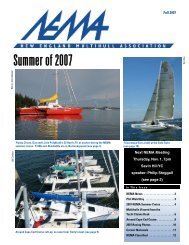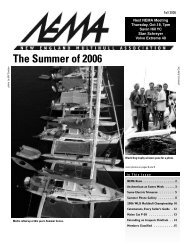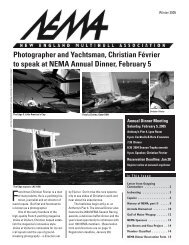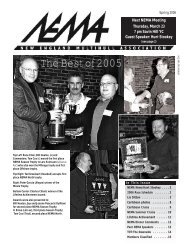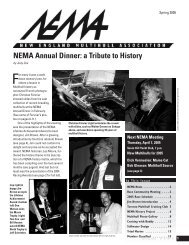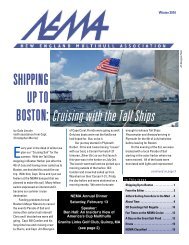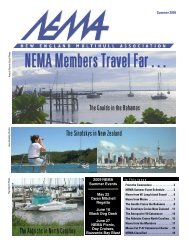NEMA Newsletter - New England Multihull Association
NEMA Newsletter - New England Multihull Association
NEMA Newsletter - New England Multihull Association
Create successful ePaper yourself
Turn your PDF publications into a flip-book with our unique Google optimized e-Paper software.
Photo Courtesy of Stan Honey<br />
4<br />
<strong>NEMA</strong> Dinner<br />
Groupama 3<br />
(continued from page 3)<br />
speed.” Stan later showed a slide of the<br />
navigation display when off the coast of<br />
Brazil, indicating 7 knots of true wind and<br />
20 knots of boatspeed, exclaiming “G3 is<br />
a rocket in light wind and flat water!”<br />
On the final North Atlantic leg of<br />
their circumnavigation, Orange 2 had<br />
slowed for 2 ½ days to let a storm go by<br />
ahead of it, as Peyron was about 10 days<br />
ahead of the record at that point, and felt<br />
that he could afford to be conservative to<br />
protect the boat. Aboard G3, they knew<br />
that they could shave those 2 days from<br />
Orange 2’s time, so they pushed to get<br />
out ahead of the last storm to ensure<br />
they’d break the record.<br />
Life On Board G3<br />
One of Franck’s goals was to get<br />
around the world without breaking the<br />
boat, so he selected a very experienced<br />
crew whose average age was 45, with<br />
Franck the youngest and Stan the oldest<br />
on board. Everyone except Franck had<br />
already been around the world at least<br />
once.<br />
Stan Honey remarked that it was a<br />
privilege to be asked to join the relatively<br />
closed world of French sailing, and that it<br />
provided an interesting contrast to other<br />
N E M A Spring 2011<br />
campaigns. The food, for<br />
example, was the same<br />
dehydrated stuff that’s<br />
used in the Volvo races.<br />
The professional Kiwi<br />
crews Stan usually sails<br />
with “dump it all in one<br />
pot and stir it with a<br />
screwdriver” as part of<br />
their general hard-guy<br />
approach. Onboard G3 it<br />
was the same ingredients,<br />
but it was cooked<br />
properly, with care, and<br />
with an occasional dollop<br />
of olive oil or a bit of<br />
spice, it tasted markedly<br />
better.<br />
The Kiwi attitude is<br />
that brutal conditions are<br />
simply part of the job; they<br />
accept extremely wet conditions<br />
belowdecks on Volvo 70s, for example.<br />
G3, by contrast, had no leaks and was<br />
completely dry below! Kiwis tend to be<br />
more rule-bound, such as prohibiting<br />
coffee on deck and visits to the navigator.<br />
The French were generally more<br />
sociable, to the extent of having a “Bar<br />
des Sports” game session once a week<br />
or so, with even a tiny bit of wine or<br />
cheese. When asked about his French<br />
language skills, Stan answered that he<br />
had done some preparation beforehand<br />
and by the end of the voyage he was able<br />
to discern “whether they were discussing<br />
boats or women” at conversation<br />
time. Complex navigation concepts<br />
were expressed in English, which Franck<br />
Cammas speaks well. It was very noisy<br />
belowdecks, and the motion was so<br />
extreme, with rapid accelerations in all<br />
directions, that Stan often couldn’t use a<br />
computer mouse at all, and even<br />
manipulating a trackball was difficult in<br />
these conditions.<br />
The watch schedule—as is common<br />
with professional crews in long races—<br />
was 3 hours on duty, followed by 3 hours<br />
on standby suited up and ready, and then<br />
3 hours off duty. The navigator was on<br />
24-hour standby (!), which meant that<br />
Stan Honey participated in every<br />
maneuver and, as one of the physically<br />
largest crew members, he was usually<br />
on the grinders. The crew used hand<br />
signals to communicate and there was<br />
very little talk during maneuvers while<br />
they just kept an eye out for the timing of<br />
each move.<br />
Asked about the use of foils, Stan<br />
explained that 20 knots was a transition<br />
point: below 20 knots of boat speed, they<br />
used only the center daggerboard and<br />
above that speed they used the lee foil<br />
and raised the main daggerboard.<br />
The propulsion engine, shaft,<br />
propeller and associated items had all<br />
been removed before departure.<br />
Electrical power on board was supplied<br />
by a tiny single-cylinder 7 hp diesel<br />
generator, which was hand-started with<br />
a Briggs & Stratton pull cord. It put out 60<br />
amps at 24 volts and was run about 45<br />
minutes each day to charge the Li-Ion<br />
batteries and make water.<br />
Photo Courtesy of Stan Honey



